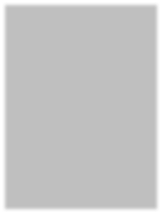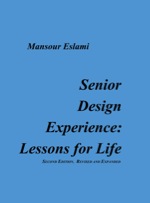NEW BOOKS
Senior Design Experience: Lessons for Life, Second Edition, Revised and Expanded by Mansour Eslami, Chicago IL: Agile Press, xvi + 344 pp., Dec. 2007, ISBN 978-0-9718239-1-4, Library of Congress Control Number 2007905193. (Website: agilepress@agileresearch.com)


We often differentiate engineering education from its counterparts in mathematics and basic sciences by a sequence of engineering design courses, which are developed subject to a number of real-world constraints. These design courses are intended to put students through a process of deliberating and considering a number of options simultaneously as practicing engineers do daily. However, the technical design or contribution as conducted by engineers is just one tile on the vast mosaic of an engineering enterprise. Future engineers must learn both social and technical skills in order to interact with multi- and inter-disciplinary teams of professionals who are conducting diverse functions. We must teach students that all their technical expertise will be in vain, if they lack communication and teamwork skills, in order to interact appropriately with all these “non-technical” professionals, and bring together a product to the market place in a manner to make sufficient income to sustain an engineering operation. Correspondingly, to incorporate these concepts with their own complexities in engineering education will challenge us; and will require us to rethink our entire educational approach and to incorporate an ensemble of new trends and fields in our curriculum. Certainly, we are not advocating double or triple majors, overlapping engineering with other disciplines. Rather we want to advocate a robust educational policy that emphasizes openness to new ideas and trends, which are outside the main stream of classical engineering curricula.
To that end, we must not rest until we educate our students in a balanced way, by improving in many dimensions both their technical and social skills, with a strong sense of ethics and societal responsibilities, as well as a basic knowledge of the business world through rules of Commerce and Entrepreneurship. To educate students about these “non-technical” trends though highly specialized, which they will face in their careers, is our goal. Looking at these concepts and understanding the thoughts behind inquisitively, is also a process that we hope to initiate in our students.
It seems, some of the current engineering educational trends are producing graduates who are doing very well on one axis, or in a one-dimensional setting, but if the condition changes, many of them do not know, nor are they equipped as to, how to respond accordingly. Our goal is to give a capability to graduating students to maneuver in a multi-dimensional setting. If and when that performance happens, the opportunities of being most productive are vast and worthy of all our efforts in attaining such an educational trend. We are optimistic and as we proceed in the textbook, we demonstrate that we have chosen the right approach to achieve this goal.
In this textbook, we present a platform consisting of a list of possible “non-technical” topics. However,
-
•first, we recall that at the university, we are in the business of creating and transferring knowledge. We can demonstrate our creativity and research outputs as extensively as we please, but ultimately our overall success and the ranking of our institution will depend on the success of our graduates as our final products.
-
•Second, the author's orientation has always been toward the final products concept, and his students' outputs spanning from 1980's to date is a testimony to this claim. With this level of commitment and dedication, he looks at students to see how well they are equipped to tackle the engineering problems, and how well we have transferred the knowledge to them.
Thus, we have proposed that our students experience the whole picture in order to succeed in the new world-order setting. Our list of topics is an ensemble of new trends and is prepared based on the fact that each engineering program must have a meaningful and major, though non-fragmented, engineering design experience, which builds upon technical, scientific, business, social and behavioral sciences. While teaching as such challenges us to the core, that bridging aspect between the engineering and the outside world, that is a unique feature of this book, will remain with students forever.
The book consists of four parts.
PART ONE: COURSE ADMINISTRATIVE ISSUES
General guidelines and administrative requirements of this course, including a senior design contract and issues on scheduling, are reviewed. This part also explains the commonalties of a general contract.
PART TWO: COURSE LECTURE NOTES
This part opens with an expanded Lecture Zero that covers certain organizational matters in an engineering firm with some original perspectives on these matters. It follows with a set of 24 coherently assembled, revised and expanded, lecture notes to address commonalties in these engineering design courses; in order to satisfy the requirement on the lecture part of the course. Also it provides for training in the so-called “non-technical” issues in engineering education, as is the main purpose of this book.
Lecture One: Introduction and Course Outline
Lecture Two: Preliminary Issues, Expectations & Professionalism
Lecture Three: Final List of Projects and Contracts
Lecture Four: Laboratory Notebook and Proposals
Lecture Five: Proposals and Memos Continued
Lecture Six: Steps Towards Oral Presentations - Phase I
Lecture Seven: Technical Writing - Phase I
Lecture Eight: Marketing High-Tech Products
Lecture Nine: Marketing High-Tech Products (Continued)
Lecture Ten: In Preparation for the Design Review
Lecture Eleven: Ethics
Lecture Twelve: Design Review Preparation - The Final Thought
Lecture Thirteen: Mid-Course Design Review Results
Lecture Fourteen: Technical Writing - Phase II
Lecture Fifteen: In Preparation for the Final Report
Lecture Sixteen: Steps Towards Oral Presentation - Phase II
Lecture Seventeen: Engineering Economics
Lecture Eighteen: Entrepreneurial and Venture Capital
Lecture Nineteen: Entrepreneurial and Venture Capital (Continued)
Lecture Twenty: Quality Control
Lecture Twenty One: Intellectual Property Issues
Lecture Twenty Two: Intellectual Property and Patents
Lecture Twenty Three: Risk Management
Lecture Twenty Four: In Preparation for the Final Presentation.
Most of these lectures take more than an hour, perhaps up to 90 minutes to present. The textbook is suitable and prepared for a two-term design course.
PART THREE: SAMPLES of STUDENT’S WORK
Here, the author shares a few samples of the earlier work from his rich reservoir of talented and motivated students to demonstrate how things have been done in his classes.
PART FOUR: EPILOGUE
In this part the author’s final thought and reflection on the course are presented. The book closes with sections on References and Index.
Finally, it is believed that this is truly a well-rounded educational textbook that prepares students for research and scholarly work with a savvy business mind and positive attitude to succeed as well as a good outlook for life.
NB: Agile Press distributes its own books, and has no affiliations with any online outlet. See agilepress@agileresearch.com.




